December 25. PELLING (SIKKIM) "The Christmas Monastery Tour" It was Christmas in Sikkim and in a relatively remote and predominantly Buddhist area we saw some unexpected tributes to the Christian faith or at least the spirit of the holiday. In our hotel restaurant a little tree sat on the counter, decorated with tinsel, and a sign draped over the edge read "Merry Christmas". The family that owned the hotel was Bhutia, a local group of Tibetan origin. One wall of the restaurant had an image of the Potala Palace in Lhasa. The tables and chairs that filled the room were sort of a mixture and gave the place a homey feeling. Somehow, in an odd way, that little tree just seemed to fit right in. But, a more serious Christmas display was down the hill from our hotel. Someone had actually constructed a small church out of wood, straw, and cardboard and inside, on a blanket, was a frame holding an image of Christ. It seemed likely that this was a Christian family for them to have gone to so much trouble to celebrate the religious significance of the holiday, not just the festive tree and man dress like Santa. We had seen a Catholic Church in Gangtok as well as other Christian denominations. the counter, decorated with tinsel, and a sign draped over the edge read "Merry Christmas". The family that owned the hotel was Bhutia, a local group of Tibetan origin. One wall of the restaurant had an image of the Potala Palace in Lhasa. The tables and chairs that filled the room were sort of a mixture and gave the place a homey feeling. Somehow, in an odd way, that little tree just seemed to fit right in. But, a more serious Christmas display was down the hill from our hotel. Someone had actually constructed a small church out of wood, straw, and cardboard and inside, on a blanket, was a frame holding an image of Christ. It seemed likely that this was a Christian family for them to have gone to so much trouble to celebrate the religious significance of the holiday, not just the festive tree and man dress like Santa. We had seen a Catholic Church in Gangtok as well as other Christian denominations.
The weather was slightly overcast so we didn't get our spectacular view of Kangchendzonga but the little town of Pelling was refreshing, crisp clean air and that feeling of being "out there". It was small and not particularly scenic in and of itself but perched high on the mountain at 2085 meters (6840 feet) it was in a very scenic location. The town pretty much just existed along a few steep zigs and zags of the road and it had that cozy feeling that came with being in a place so remote.
Our jeep picked us up in front of the hotel. The driver was a young guy and didn't speak much English but seemed like a happy fellow. Our first stop was about fifteen minutes away from Pelling at Pemayangtse Gompa, one of Sikkim's oldest and most 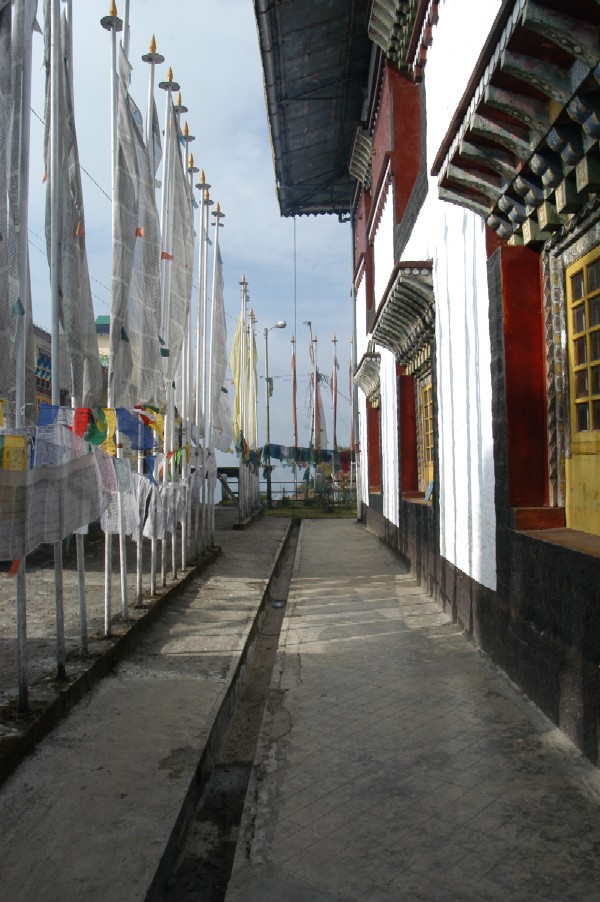 important monasteries. Pemayangtse belongs to the Nyingmapa sect of Tibetan Buddhism, which was founded by Padmasambava, and is currently headed by the Dalai Lama. The name, Pemayangtse, name means "Perfect Sublime Lotus". The structure itself had been rebuilt a number of times and the interior had been completely redone in 2002 but the serene location of the monastery was idyllic. The monastery only consisted of one main hall and a handful of smaller buildings but a row of tall flowing white prayer flags greeted us as we pulled into the parking lot with more prayer flags flanking the main hall. Our driver parked and waited in the jeep while we took a stroll around. We were the only tourists but had seen a group of westerners walking up the road and knew our solitude would be short lived. Just up from the parking lot we encountered a small building that housed an enormous prayer wheel. Mani (prayer) stones were placed in some of the windows along the outside the gompa. Inside the main hall a small group of monks were chanting and playing instruments. We sat along a side wall and watched in silence for a while before quietly taking a walk around the beautifully painted walls. The monks soon finished their morning puja and began preparing their meal, filling bowls with rice. important monasteries. Pemayangtse belongs to the Nyingmapa sect of Tibetan Buddhism, which was founded by Padmasambava, and is currently headed by the Dalai Lama. The name, Pemayangtse, name means "Perfect Sublime Lotus". The structure itself had been rebuilt a number of times and the interior had been completely redone in 2002 but the serene location of the monastery was idyllic. The monastery only consisted of one main hall and a handful of smaller buildings but a row of tall flowing white prayer flags greeted us as we pulled into the parking lot with more prayer flags flanking the main hall. Our driver parked and waited in the jeep while we took a stroll around. We were the only tourists but had seen a group of westerners walking up the road and knew our solitude would be short lived. Just up from the parking lot we encountered a small building that housed an enormous prayer wheel. Mani (prayer) stones were placed in some of the windows along the outside the gompa. Inside the main hall a small group of monks were chanting and playing instruments. We sat along a side wall and watched in silence for a while before quietly taking a walk around the beautifully painted walls. The monks soon finished their morning puja and began preparing their meal, filling bowls with rice.
We continued our tour upstairs, past the monks and their food preparations in the adjacent hallway, bowls and pots spread out across the floor. The second level of the gompa consisted of a large prayer hall, facing towards the front of the monastery, with a pantheon of statues lined up along the back. Behind prayer hall was a smaller room with Buddhist scriptures stacked to the ceiling. We took our time looking at the images until we heard the tour group coming up the stairs. When they arrived we headed to the top story of the monastery. O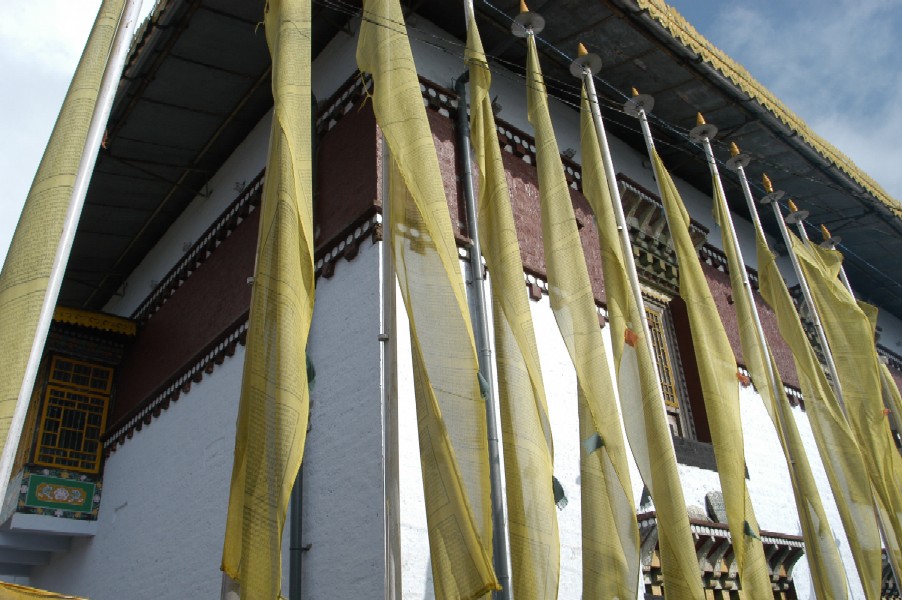 n the top floor was just one fairly small room with high ceilings, brightly lit with high windows. In the middle was an elaborate wooden model encased in Plexiglas on all four sides. It was a seven-tiered painted model of the abode of Padmasambava, called Zandog Palri. It was reputedly built in five years single-handedly by the late Dungzin Rinpoche. It was done with immense detail, each layer exhibiting different deities and illuminated in an explosion of colors. The model was positioned in the center of the room so we cold make a circumambulation of it and view all sides. We lingered there until the tour group arrived and then returned to the middle floor to look at the images a bit longer. This monastery had some of the more revealing images that we had seen. While copulating deities, demonstrating a union between two halves, wasn't uncommon in Buddhist imagery the monasteries sometimes "cloaked" them so as to obscure the intimacy, but not at this monastery. n the top floor was just one fairly small room with high ceilings, brightly lit with high windows. In the middle was an elaborate wooden model encased in Plexiglas on all four sides. It was a seven-tiered painted model of the abode of Padmasambava, called Zandog Palri. It was reputedly built in five years single-handedly by the late Dungzin Rinpoche. It was done with immense detail, each layer exhibiting different deities and illuminated in an explosion of colors. The model was positioned in the center of the room so we cold make a circumambulation of it and view all sides. We lingered there until the tour group arrived and then returned to the middle floor to look at the images a bit longer. This monastery had some of the more revealing images that we had seen. While copulating deities, demonstrating a union between two halves, wasn't uncommon in Buddhist imagery the monasteries sometimes "cloaked" them so as to obscure the intimacy, but not at this monastery.
When we returned to the main hall we found one very old monk still sitting there. We smiled and he smiled as we began to make a final pass around the images. He asked where we were from and we replied but his English was a bit rough to talk much more. We commented on the beautiful images and politely left a donation before we leaving through the main door. In front of the hall was a green lawn with a tall poll in the middle. The poll was adorned with a yellow prayer flag, flapping wildly in the wind, and around the pole the grass had been worn away by the constant tread of pilgrims as the circumambulated the pole. Some little kids were playing on the grass, chasing each other. I took time to ma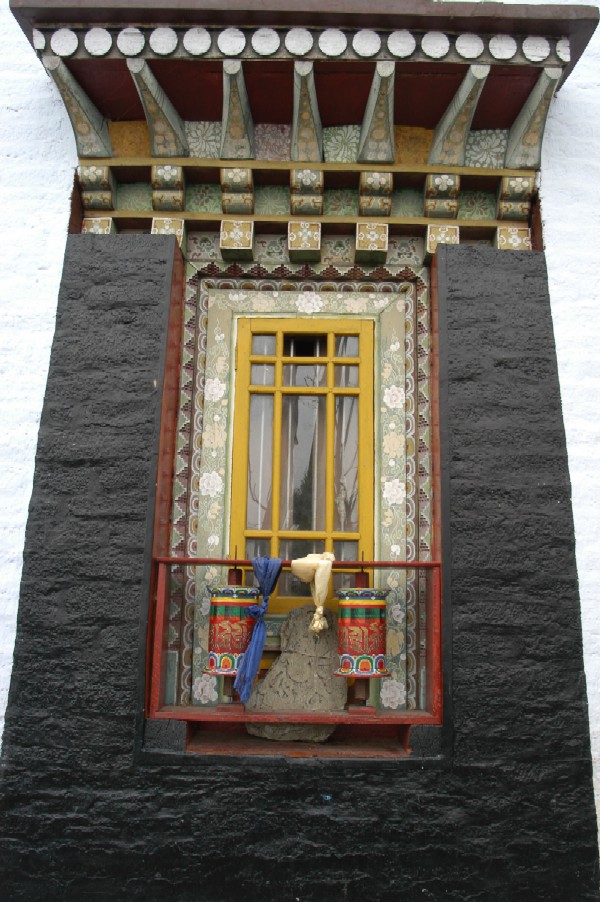 ke three circumambulations before we continued back around the monastery to the parking lot. Before heading down the stairs we were caught by a couple of monks who, in the time since we arrived, had set up a ticket desk. The fee was nominal so of course we paid it but I always felt less inclined to leave a donation when I am asked to purchase a ticket and we had already left the donation. The guidebook indicated there wasn't any fee for visiting the monastery so this was a new revelation. Unfortunately, I am sure it is the result of too many thankless tourists who were visiting and not making donations. After all it is an imposition on their day to deal with people who are not necessarily versed in the tradition of Buddhism or the proper way to act in a monastery. ke three circumambulations before we continued back around the monastery to the parking lot. Before heading down the stairs we were caught by a couple of monks who, in the time since we arrived, had set up a ticket desk. The fee was nominal so of course we paid it but I always felt less inclined to leave a donation when I am asked to purchase a ticket and we had already left the donation. The guidebook indicated there wasn't any fee for visiting the monastery so this was a new revelation. Unfortunately, I am sure it is the result of too many thankless tourists who were visiting and not making donations. After all it is an imposition on their day to deal with people who are not necessarily versed in the tradition of Buddhism or the proper way to act in a monastery.
Our second stop for the day was Tashiding Monastery, perched on a hilltop across the valley from Pelling. We retraced the road we'd come up on the night before, passing through the nearby village of Geyzing and weaving our way down to Legship, at the river. The drive wasn't nearly as harrowing as it has been at night but it was a very steep and winding descent. At Legship we crossed the river and headed up a side valley, traversing along the hillside with the river in view until we came upon another bridge. The second bridge was a narrow metal suspension bridge that looked fragile as it stretched wide across the river but was solidly built. The tires made a purring noise as we zipped across the metal grating. On the other side we started our winding ascent up another steep hillside. On a map Tashiding looked like it was practically next to Pelling but we had to descend thousands of feet and go back up thousands of feet to reach our destination.
The final ascent to Tashiding was on foot so our driver let us out at the head of the pathway and waited for us to return. A dirt and cobblestone pathway led uphill for about a mile and a half, past mani stones, prayer flags and houses. The first part of the walk was very serene but as we got closer to the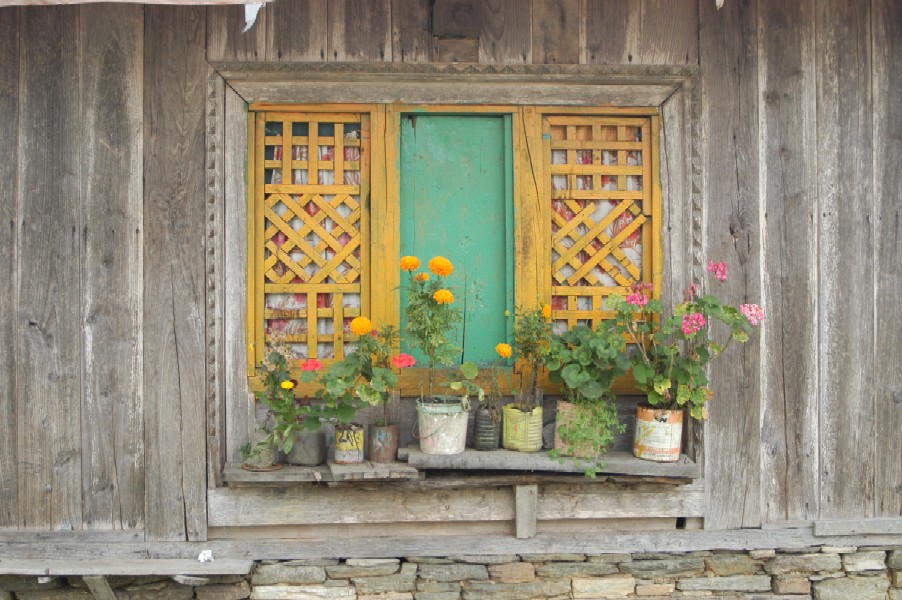 monastery more little houses popped along the pathway and we began to see more people. It was still very peaceful with people just going about their daily business. About three quarters of the way to the top we found an enormous mani stone painted in green. Nearby some children were playing and came over to check us out. Surely they had seen tourists before but they still found us entertaining. Rob was shooting some video and turned his screen so they could see themselves. The littlest of them just stared at the camera, looking a bit skeptical about the whole thing, and finally tossed a paper plate in Rob's direction before running off. That made the other kid's laugh and the mother smile. monastery more little houses popped along the pathway and we began to see more people. It was still very peaceful with people just going about their daily business. About three quarters of the way to the top we found an enormous mani stone painted in green. Nearby some children were playing and came over to check us out. Surely they had seen tourists before but they still found us entertaining. Rob was shooting some video and turned his screen so they could see themselves. The littlest of them just stared at the camera, looking a bit skeptical about the whole thing, and finally tossed a paper plate in Rob's direction before running off. That made the other kid's laugh and the mother smile.
Continuing up the trail we picked up a couple of kids that chatted with us the rest of the way to the top. They looked about seven years old but the older one was actually twelve, the difference diet can make. He spoke some pretty good English and had plenty of questions for us. When the path ended at the monastery we started our tour by visiting the large prayer wheel housed in its own little building. The kids joined us as we walked around the prayer wheel, a bell dinging each time the wheel made a full circle. The main hall wasn't much farther along. As we got closer we noticed a group of monks sitting on the grass, shaping some dough into tall cones that would be used as offerings. Off to the side another monk was getting his head shaved. It was just daily business for the monks as well. We greeted them and they nodded as they went about their cone rolling. The whole community of Tashiding, both its lay people and the 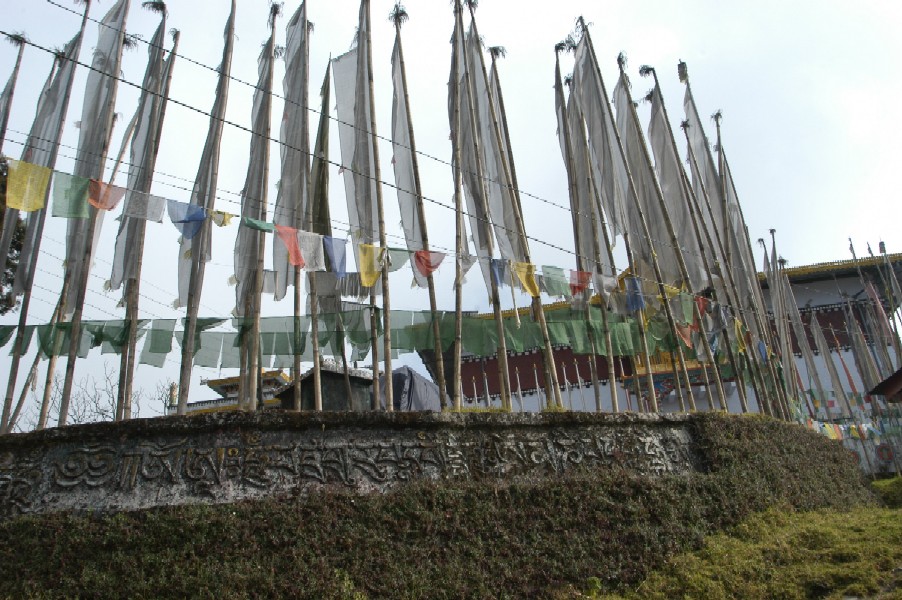 monks, made us feel very at ease. It was rare to visit a known place and be so casually welcomed. We just felt like ordinary people and it made us want to be even less like tourists so we were relaxed about taking photos, being careful not to intrude and ruin the casual rapport. monks, made us feel very at ease. It was rare to visit a known place and be so casually welcomed. We just felt like ordinary people and it made us want to be even less like tourists so we were relaxed about taking photos, being careful not to intrude and ruin the casual rapport.
Tashiding Gompa is considered one of Sikkim's most sacred monasteries, having been founded in 1641 by Ngadak Sempa Chempo, one of the three lamas who brought Buddhism to Sikkim. But, there was no pretense about Tashiding that would reveal its important status and perhaps that is what made it feel so absolutely genuine. I had seen quite a few gompas over the years, from Mongolia to the Tibetan plateau to Nepal and now Sikkim, and not all reflected the humble and compassionate nature of the religion but Tashiding felt real. The main hall wasn't very big but the interior had recently been repainted and it had been done very well. Some Christmas lights were hung around the altar but probably had nothing to do with it being Christmas and an assortment of colorful butter and dough sculptures were lined up on a platform near the front.
A group of puppies were scurrying about and our two little friends were chasing them. They made an irresistible photo. On the far side of the main hall there was a small building full of lamps, lit as offerings. Some boys were busy cleaning out the room and preparing more lamp oil, probably ghee. The temple complex was scattered over the hilltop, narrowing at the far end where a large mani stone walled cemetery sat with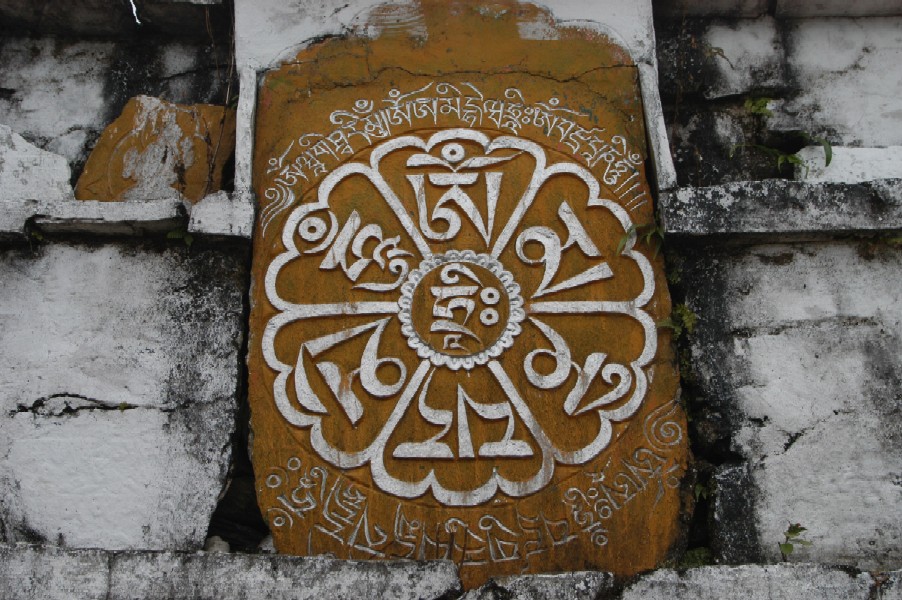 row of pristine while stupas, relic chambers. The wall was made up of colorful mani stones and a forest of prayer flags rippled in the wind. Near the very end of the wall, on the outside of the cemetary, we found a tiny workman's nook covered with a wooden overhang. It was built right up alongside the wall and was where all of those many mani stones had been born. row of pristine while stupas, relic chambers. The wall was made up of colorful mani stones and a forest of prayer flags rippled in the wind. Near the very end of the wall, on the outside of the cemetary, we found a tiny workman's nook covered with a wooden overhang. It was built right up alongside the wall and was where all of those many mani stones had been born.
We finished our long elliptical circumambulation of the Tashiding and came back to the monks on the grass, still busy with their cone shaping. We smiled again and thanked them before heading back towards the village. We lost our two companions but met more people as we passed back through the village. From the window of one small home we saw a boy waving vigorously at us with a smile on his face. The homes were small for the number of people they held - our little twelve year old friend came from a family of some eight or ten kids - but they were colorfully decorated and neatly maintained with flowers and prayer flags. Back at the bottom of the trail we patiently found our driver waiting for us.
We made our twisty-turny way back down the hillside, back across the bridges and to the town of Legship. Our driver asked if we wanted to stop for lunch, since we hadn't eaten the entire day, but we were prepared to wait until Pelling. Afterwards we wondered if he needed something to eat so perhaps we should have let him stop. During all of the time we had been gone we just figured he'd brought food or bought something but that may not have been the case. We should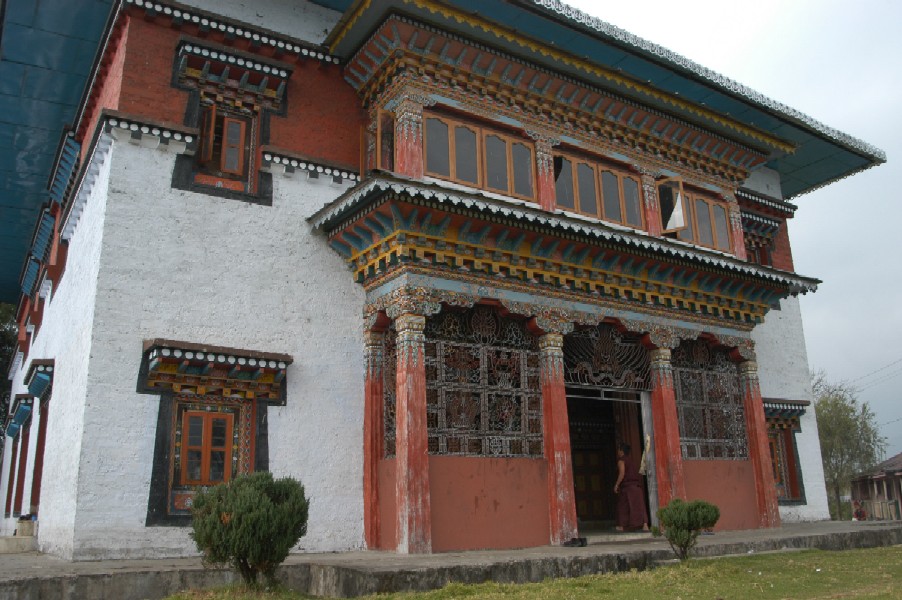 have asked. At any rate, it wasn't that long before we were back in Pelling. have asked. At any rate, it wasn't that long before we were back in Pelling.
The group we had chatted with the night before was gone. We'd seen the Czech couple at breakfast but they had gone trekking and the Dutch and American guys were nowhere to be found. Instead we had a group of lively Indian tourists. One of them came over to talk with us and sort of hovered over our table but we were getting tired and didn't stay in the restaurant too long. Our room had frequent power outages but we were eventually able to clean up and get to bed. |
SRI LANKA
Colombo
Oct 25
Oct 26
Oct 27-29
Nuwara Eliya
Oct 30
Oct 31
Kandy
Nov 1-5 (1)
Nov 1-5 (II)
Polonnaruwa
Nov 6
Sigiriya & Dambulla
Nov 7
Colombo
Nov 8
INDIA
Ft.Cochin
Nov 9-15 (I)
Nov 9-15 (II)
Nov 16
Nov 17-18
Madurai
Nov 19
Nov 20
Tiruchirapalli
Nov 21
Nov 22
Nov 23
Chennai
Nov 24
Nov 25-26
Nov 27-28
Ft.Cochin
Nov 29
Lakshadweep
Nov 30-Dec 4 (I)
Nov 30-Dec 4 (II)
Trans-India Train
Dec 5-7 (I)
Dec 5-7 (II)
Siliguri
Dec 8
Darjeeling
Dec 9
Dec 10-13
Dec 14
Sikkim
Dec 15
Dec 16-20
Dec 21-23
Dec 24
Dec 25
Darjeeling
Dec 26
Dec 27-Jan 2
Siliguri
Jan 3
Jaigon
(Bhutan)
Jan 4
Kolkata
Jan 5-6
THAILAND
Bangkok
Jan 6-13 (I)
Jan 6-13 (II)
Jan 6-13 (III)
|

